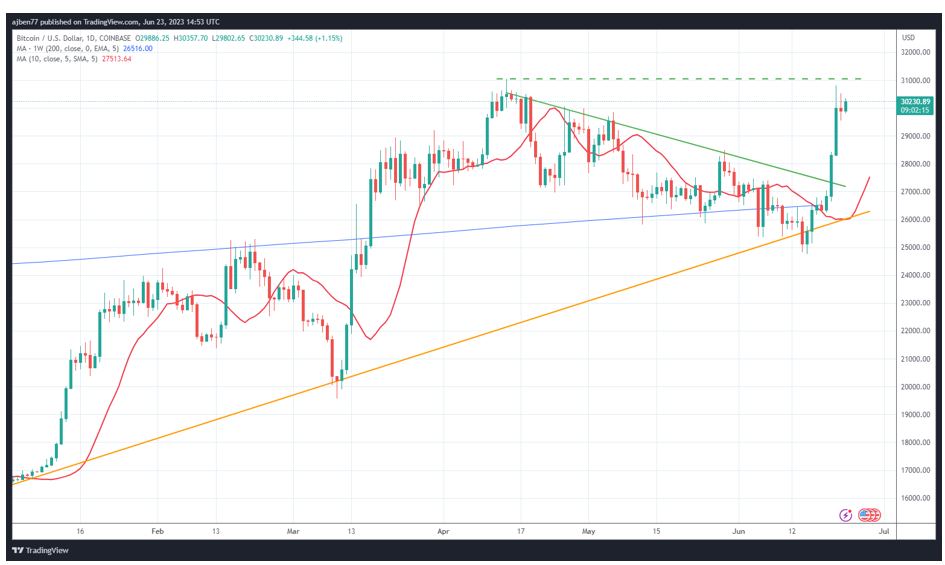Bitcoin Defies Trend Amid Correction
 |
| By Juan Villaverde & Alex Benfield |
Over the past week, the world has seen a divergence in global markets.
In the U.S., the Federal Reserve put a hold on its rate hiking journey — an action so thoroughly predicted that it led to no significant change in the market.
Meanwhile, the EU and U.K. central banks are playing catch-up with the Fed, continuing with rate hikes that they started later than the U.S.
Over in Japan, the scenario remains unchanged with unabated money printing and zero interest rates. And China continues its path of currency debasement through ongoing cuts to key policy rates.
This divergent approach among the world's central banks — some easing like China and Japan, some pausing like the Fed and others hiking like the U.K. and EU — creates crosscurrents, resulting in markets having trouble interpreting this policy divergence.
Therefore, asset classes are diverging as well, with gold heading downward, bonds stuck in limbo and the stock market continuously hitting new highs for 2023.
In this complex environment, the crypto market is no exception. The altcoin market, significantly affected by the Securities and Exchange Commission’s lawsuits, has seen its combined market capitalization — excluding Bitcoin (BTC, “A-”) and Ethereum (ETH, “B”) — fall back to bear market lows.
You see, the chart of altcoins indicates that the bear market hit its low in late 2022, precisely on Dec. 30.
Following a double top formation between February and April, altcoins fell by over 20% to their bear market lows. This drop contrasts with Bitcoin and Ethereum, which doubled their prices at their April peaks.
Given these trends, it seems that the altcoins may have peaked and are unlikely to surpass their early 2023 highs until 2024.
While stronger than altcoins, Ethereum's situation follows a similar downward trajectory since its April peak. Namely, Ethereum's struggle to surpass the $2,000 mark, its subsequent peak around $2,100 on April 14 and its recent low on June 14 paints a similar picture to that of altcoins.
Indeed, the Ethereum chart indicates that it set a yearly top and that this rally likely won’t exceed $2,000 before ETH declines further.
These developments in the crypto market align with those seen in gold and bond markets, both of which also established significant cycle peaks in April and May. This alignment suggests that a multi-month correction has likely started in these markets.
However, Bitcoin is bucking the trend. After briefly dipping below its orange uptrend line last week, it immediately reversed and began soaring higher. Currently trading at $30,000, Bitcoin is just shy of hitting its April peak of $31,000, suggesting a potential breakout.
Two primary factors drive this surge: BlackRock's (BLK) Bitcoin exchange-traded fund application and the SEC's exemption of Bitcoin from enforcement.
While it's possible for Bitcoin to be the lone crypto reaching new highs, we should not take it for granted. Over the past few years, Bitcoin has often lagged behind other crypto assets — notably Ethereum.
This unusual rally leads me to speculate that Bitcoin might pull back before surpassing its April peak.
Regardless of the outcome, crypto markets are in a pivotal moment. After all, a Bitcoin-led breakout to new 2023 highs is absolutely not out of the question.
Now, let’s turn to Alex for his take on this current situation.
Bitcoin on the Brink of Topping Its Yearly High?
To start, I would like to emphasize that last point Juan made: Our Crypto Timing Model and analysis is currently leading us to believe that the yearly high is in for the crypto market. So, we should expect a decline in prices, but neutral conditions overall until the end of the year.
However, there remains the possibility that Bitcoin could break above its yearly high of $31,000 and trigger a rally within the rest of the crypto market.
The crypto market has been more unpredictable than usual this year, and we’ve had to reevaluate some of our theses. Nonetheless, we are currently prepared for either outcome and ready to take advantage of whatever conditions the market throws at us.
As Juan said, BTC did briefly break below its orange uptrend line, which is the main reason we are so cautious about the current rally. However, it is incredibly close to breaking above its yearly highs.
So, the next few days will be crucial for Bitcoin and the crypto market as a whole. The key level to watch is that green dashed line, which represents the yearly high. If BTC can close above that level and hold it for a few days, then this rally could grow legs.
But if BTC closes below that orange uptrend line again, then that $31,000 level is likely to hold as the yearly high.

Overall, the market is either at the beginning stages of a bull market that could kick off as soon as Bitcoin breaks above its yearly highs … or there is one last period of hibernation left before things kick into high gear.
Regardless, the scene has been set for the next bull market. During 2020 and 2021, the rumors of institutional money entering the space were enough to kick-start a massive price run.
Sure, some institutions did begin to allocate into crypto, but hardly at the scale many analysts had predicted. It left something to be desired.
Mainly, a spot Bitcoin ETF.
Conveniently, massive institutional giant BlackRock has just applied for a spot Bitcoin ETF. That could be the financial product that onboards a boatload of capital from the traditional finance world into the crypto market and kicks off the next big bull run.
Better yet, we might not have to wait too long to get an answer on whether the application will be accepted. Rumor has it that the SEC could accept BlackRock’s application at the first possible window approximately 45 days after it was submitted, which would be sometime around the U.S. Labor Day holiday.
As we navigate the close of this year, the stage seems set for what could be a seismic shift in the crypto market. While we brace ourselves for potential volatility and await the outcome of BlackRock's Bitcoin ETF application, there's a palpable sense of anticipation in the air.
Will this indeed be the long-awaited financial product that heralds a new wave of TradFi capital into the crypto market, igniting the next significant bull run? Or will it be yet another twist in the ongoing saga of crypto's path to mainstream adoption?
This autumn could hold the answers to these questions. And the implications of such a decision could be profound, potentially leading to an influx of institutional money that would turbocharge the crypto market.
Whichever way the coin flips, we're prepared for every possibility. As we continue to analyze market trends and adjust our strategies accordingly, we remain committed to keeping you informed and helping you navigate these exciting yet challenging times.
After all, unpredictability is part and parcel of the crypto world — it's what keeps us on our toes and what makes this journey so intriguing.
Best,
Juan & Alex

